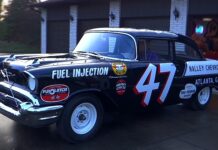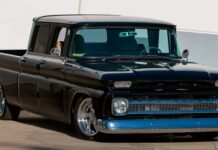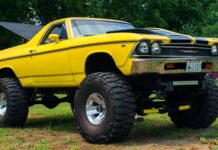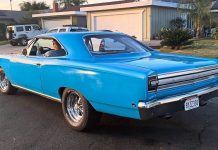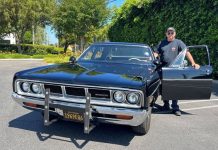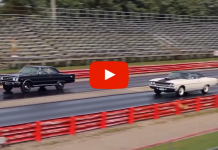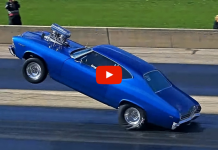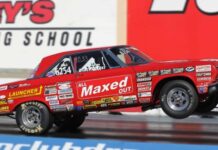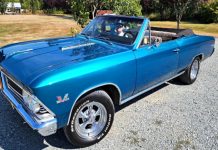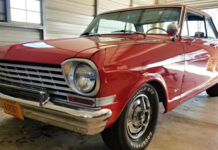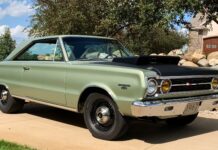There's no feeling quite like bringing a classic beauty back to life through classic car restoration. Breathing new life into a vintage ride not only preserves a piece of automotive history but also connects us to a time when craftsmanship and style were at the forefront.
In this ultimate step-by-step guide, we're gonna take you on a wild ride through the ins and outs of restoring a classic car. From selecting the perfect project car to showcasing your restored gem at local car shows, we'll cover every aspect of this exciting journey.
With this guide, you'll be equipped with all the knowledge and know-how to tackle your classic car restoration project. So, let's shift gears and get started on the road to automotive glory!
Pre-Restoration Considerations: Setting Yourself Up for Success in Classic Car Repair
Before diving headfirst into the thrilling world of restoring classic cars, consider a few factors that can make your life easier in the long run for auto restoration.
The Planning Phase: Charting Your Course for Auto Restoration
When it comes to planning classic car repairs, there are several essential questions to ask yourself for your restored muscle car project:
- What's your budget for complete car restoration and repairing classic cars?
- What's your timeline for completion? Do you have a specific deadline in mind? Keep in mind that your budget will affect your timeline for classic car repairs.
- Where will you be working on your classic car? Do you need a garage for auto restoration, or can you work on your car from home?
- Do you know the step-by-step process of restoring a classic car? Learn what to expect to decide if it's right for you and complete car restoration.
You don't have to know the exact answers, but getting a ballpark estimate will help you be better prepared and less stressed during classic car repairs. As your project develops, you can always go back and fill in the details of auto restoration.
Determining Your Classic Car Restoration Budget
If you're working with a tight budget for your classic car restoration, careful consideration is necessary. You need to assess how much you can allocate for the entire restoration process, including the car itself, tools, and necessary parts. Whether it's a custom car restoration or a classic auto restoration, budgeting is key.
Before purchasing a classic car for restoration, decide whether you intend to fully restore it to its original driving condition or if it will be a cherished addition to your collection for occasional drives. This decision will impact your restoration approach and the level of detail involved in the process.
For a comprehensive restoration, whether it's a custom car restoration or a classic restoration, it's important to remember that you'll need to acquire various parts along the way. Additionally, if you don't plan to handle the entire process yourself, you might need to set aside some extra funds for professional assistance.
If you already have a particular car in mind for restoration, you likely have an idea of your budget. When facing tight financial constraints, explore local junkyards, eBay, Facebook Marketplace, and Autotrader for more affordable classic car options. These sources can provide opportunities for finding restoration cars at reasonable prices.
How to Find the Perfect Classic Car for Restoration
Your budget will heavily influence the type of classic car you can purchase for restoration. Utilize resources like Classic Car Value to gain insight into the potential price range for your desired vehicle. This applies to both car restoration and classic auto restoration projects.
TIP: Don't limit your search to local directories alone when looking for restoration cars. Explore platforms like eBay and CraigsList, as they often offer hidden gems suitable for custom car restoration, classic restoration, and general car restoration projects at reasonable prices.
Keep in mind that most old cars, whether they require custom car restoration or classic restoration, are not in pristine condition. Therefore, it's essential to thoroughly inspect and compare options before making a purchase. This applies to any restoration car you consider.
Some key details to consider when searching for a restoration car include the duration of the seller's ownership, the car's previous owners, and its title status. Proper documentation is crucial for any restoration car, whether it's for classic auto restoration or a custom car restoration project.
How to Keep Your Precious Ride Car Protected During the Restoration Journey?
Safeguarding your classic car project from the elements, of theft, and vandalism is paramount. Here are a few methods to shield your beloved vehicle:
- Weatherproof and Heated Garage: Optimal especially in extreme climates, ensuring both security and climate control.
- Wooden Storage Unit or Barn: Ensure proper ventilation and protection from dampness to prevent moisture accumulation within the car.
- Car Cover: While it won't deter theft, it will shield your car from sun damage, water spots, and external rust.
- Gazebo: Great for sun protection during fair weather, but not suitable for colder seasons.
Essential Tools You Can't Do Without When Restoring Your Classic Car
These eight tools will become your trusted companions throughout your restoration project. They not only make your work easier and faster but also elevate the final result with a professional touch.
1. Air Compressor
An indispensable tool for any household or vehicle-related work. It powers impact wrenches, hammers, grinders, and paint sprayers, and you'll find yourself using it frequently for various repairs and projects.
2. Creeper
Easy manoeuvrability in and around your car is crucial. A reliable creeper ensures accessibility, facilitating regular vehicle maintenance and minor repairs for years to come.
3. Floor Jack
When it comes to accessibility, lifting your car and its components is crucial. Having a reliable floor jack is a must-have to ensure the best access and reach. You might also find a transmission stand or engine stand useful, depending on the project. So make sure you have a few floor jacks on hand.
4. Grinder
Wondering why a grinder is necessary? A grinder will be your trusty tool for tackling minor to moderate frame and bodywork, ensuring it's done the right way. You can also use it for buffing edges and cutting metal.
5. Hand Tools
Let's talk about hand tools. The specific tools you'll need depend on what you already have in your tool collection. If you've been building your arsenal over the years, you might only require a few odd-sized combination wrenches, hex wrenches, screwdrivers, or ratchets.
However, if you're missing most of these, investing in a complete mechanic's tool set is a smart move. It ensures you have a comprehensive range of metric and standard sizes for nearly every application.
6. Welder
Taking up welding yourself may seem intimidating, but if you're up for the challenge, it can save you a significant amount of money when it comes to bodywork and frame welding.
For auto restoration, there are three types of welders to consider: MIG (metal arc welders with gas or flux-cored), TIG (tungsten arc welders with shielding gas), and Arc (traditional stick electrode).
7. Paint Stripper
If you're planning to remove paint from your vehicle using the mechanical method—good old sanding and scraping—you'll need a paint stripper tool. Many DIYers opt for this approach as it is cost-effective and simpler compared to chemical paint removal techniques.
For smaller tasks like minor paint touch-ups and rust removal, a less expensive mechanical paint stripping tool will suffice. However, if you have larger projects or a full paint job ahead, investing in a more advanced and pricier model will prove valuable. It can handle significant rust removal from metal panels with ease.
8. Dent Puller
Another handy speciality tool for body repair tasks is the dent puller. There are two main types to choose from: a hand-operated suction cup style and an automatic (pneumatic) version that works with an air compressor. Both types come in handy for various jobs of different sizes and accessibility levels.
The Ultimate Step-by-Step Guide to Classic Car Restoration
Even if you're a fly-by-the-seat-of-your-pants kind of person, some planning is essential for a successful classic car restoration project. This involves a systematic dismantling of the car, organizing the parts, and following the right sequence for rebuilding and reassembly.
Let's take a closer look at the typical process involved in classic car restoration.
Phase 1: Creating a Solid Plan
The foundation of any car restoration project lies in creating a well-thought-out plan. This ensures you have a clear understanding of the entire process, including the cost, time commitment, and the steps required to achieve your dream car. Here are the key considerations:
Budget
Determine how much you're willing to spend on the entire project and allocate funds for each section of the car. It's important not to compromise on quality as the parts you choose will greatly influence the final outcome and potential buyers' interest.
Aspirations
Decide whether you're aiming for complete restoration or focusing on specific areas like bodywork. The extent of the work determines the budget and time investment required.
Location
Since your vehicle will be stationary for a while, plan where you'll store it, ensuring easy access. Consider setting up separate areas for mechanical and bodywork, as well as electrical and upholstery.
Document Everything!
Take extensive photos and videos before, during, and after the stripping phase. It's difficult to remember how everything comes apart, so create a checklist and note which parts need replacing, repairing, or repainting. Labelling everything will save time during the rebuilding phase and can also impress potential buyers with your meticulousness.
Timelines & Goals
Create a realistic timeline for the project, taking into account the time you can dedicate. Breaking the restoration process into four parts—mechanical, electrical, body, and upholstery—can make it more manageable. Setting achievable goals along the way will help you stay on track.
Allocate separate areas for mechanical and bodywork, and electrical and upholstery. This allows you to work on different aspects simultaneously, streamlining the restoration process.
Remember, good things take time!
Tools of the Trade
Determine if you have all the necessary tools for the job. If you need to purchase new ones, consider your budget. Renting or borrowing from a friend are other options worth exploring.
Contact the Professionals
Whether you're doing the restoration yourself or seeking professional assistance, it's wise to consult experts before diving into the project. Create a list of companies or individuals you may need to contact, informing them about your project and timeline. This ensures they can prepare any necessary items to avoid delays.
What is the Final Product?
Take this opportunity to plan and visualize the final look of your restored car. Browse online for inspiration, check out Pinterest, attend car shows, and explore automotive magazines. Having a clear vision of the features you desire, such as tinted windows, will prevent last-minute decisions that you might regret.
Phase 2: Time to Get Down to Business
Now that all the planning and research are complete, it's time to roll up your sleeves and dive right in.
14 Steps to Vehicle Disassembly
Step 1: Trim Removal
Identify the screws and fasteners that secure the bumpers, grills, lights, and side trim. Take your time and handle them with care since these components can be quite costly to replace.
Step 2: Glass Removal
Start by removing the windshield. Take off the interior trim and gently release the rubber moulding that holds the windshield in place, pushing outward from the inside. Repeat the process for the rear window. To access the side windows, remove the door trim panels.
Step 3: Interior Removal
Begin by removing the door panels, followed by the seats, remaining interior window trim, carpet, and floor insulation. Proceed to remove the dash, steering column, pedals, and heater/blower box.
Find a safe and clean storage space for the removed interior components to prevent them from getting dirty or dusty. If any parts are broken, hold onto them for reference when purchasing replacements. Make a note on your checklist if any items need replacing.
If possible, remove the entire dash with the instruments intact. If not, carefully remove each piece, taking care to mark the location of all wires.
Step 4: Disassemble the Drivetrain
Remove the battery and drain any remaining fluids from the engine. Then, carefully lift and secure the engine, followed by removing the rear assembly. Moving on, it's time to take out the suspension, starting from the back and working your way to the front.
Step 5: Remove the Wiring
Now, let's tackle the wiring. Begin by removing the wiring harnesses in the rear feed, then move on to the engine bay. Finally, take out the harness in the dash. Remember to label each wiring component as you remove them to avoid any confusion. Also, keep an eye out for any damaged wires that may need replacing.
Step 6: Strip the Panelling
It's essential to determine the body type of your vehicle—whether it's unitized, monocoque, or body-on-frame. This distinction will determine how the panelling is mounted and, subsequently, how it should be removed.
Restoring a car can be like solving a complex puzzle blindfolded or as simple as assembling a few Lego pieces. The level of complexity depends on your experience and the scope of work you plan to undertake.
However, one thing is certain—it's going to require a significant investment of time and patience. Successfully restoring a car demands careful planning, thorough research, setting realistic timelines, and deciding whether you'll handle the entire process yourself or seek the assistance of professionals.
Step 7: Extracting the Engine Gearbox and Transmission
To begin, it's time to remove the powerhouse of your classic car—the engine gearbox and transmission.
This task can be made easier with the help of an engine crane. Remember, it's essential to drain all fluids beforehand to avoid any messy situations. Additionally, make sure to label the wires as you disconnect them from the engine, and don't forget to document each step with photographs.
Step 8: Remove External Panels
Moving on, we need to remove the external panels, including the bumpers, wings, trims, and clips. Take extra care during this process to prevent any damage to these components, as replacing certain clips can be quite challenging.
Carefully detach the hood, boot lid, and doors, making note of the hinge positions by scribing around their edges. This will aid in reinstallation later on.
Step 9: Removing Window Glass
When it comes to classic cars, the windscreen is usually held in place by a rubber seal that tends to deteriorate over time. Slicing through this rubber seal using a Stanley knife is the most convenient way to remove the glass.
Step 10: Safeguarding or Removing Headlights
Now, it's time to decide whether you'll be protecting your existing headlights or opting for a professional UV Protected Headlight Restoration service to revive their faded appearance before reinstalling them.
Step 11: Placing the Car on a Rotisserie
At this stage, you may encounter a slight challenge, especially if you don't have access to a rotisserie. In such cases, you can remove the rear axle and carefully position the body on top of a couple of jack stands. This will allow for better access and manoeuvrability during the restoration process.
Step 12: Clear Out the Underlying Components
Remove the front and rear suspensions, steering rack, brakes, and other parts, making careful note of items that require repair or replacement.
Step 13: Enhance Durability With Powder Coating
For metal components like bumpers, wheels, and axles that are in good condition, I highly recommend opting for powder coatings. This process not only provides a more resilient finish than traditional paint but also offers a refined look. Alternatively, you can send these parts to professionals who specialize in stripping, cleaning, and powder coating.
Step 14: Secure Replacement Parts
Take the necessary steps to order the replacement parts you need or reach out to the professionals you listed during the planning phase to make arrangements. Streamline the process and potentially save money by compiling a comprehensive list and attempting to source your parts from a single location.
Phase 3: Gettin' Down and Dirty
This is when your rusty old heap transforms into a stunning street beast. But, buckle up, 'cause you're in for a lot of elbow grease. Time for stripping, sanding, priming, and painting!
1. Strip Away All That Paint
Blasting or acid dipping the entire shell is the quickest way to remove paint, but you might need a pro for that. Otherwise, there are 3 DIY options for stripping paint.
- Your top choice is using a wire brush on an electric grinder, though it'll take ages.
- Option two is sanding off the paint, but reaching tight spots is tough.
- Lastly, the paint stripper can work, but it's messy and not as effective as the others.
2. Kiss Rust and Dents Goodbye
It's a tedious task, but you've got 3 ways to tackle rusty bits. The best (and priciest) option is removing rusted parts and welding in fresh steel. If you're going the DIY route, just know it'll be time-consuming.
Alternatively, replace removable panels like spoilers, bonnets, boot lids, and doors. The challenge here is finding rare parts. A temporary fix is to strip back rust and treat it, but that's just delaying the inevitable and not recommended.
3. Seal that Underbelly
Undersealing ain't just for looks—it's a durable, UV-stable protective layer that shields against scratches, abrasions, rust, corrosion, extreme temps, and chips.
4. Prepping for Paint
At this stage, you'll be filling, priming, and sanding before painting. Welding means filling gaps, applying an etch primer to seal the metal, and giving it a good key. Keep those panels clean at every step to avoid dust and dirt ruining the smooth finish.
Spray the shell with primer.
Gently sand the primer with 500 grit sandpaper, being careful not to sand too much or you'll need to repeat the process.
Hunt for a pro vehicle painter in Perth:
- Fix imperfections post-painting. Wet 2000-grit sandpaper helps remove dust particles or paint runs. Just don't overdo it.
- Buff your ride. Treat your car to a machine polish for a flawless finish. Check out our article on giving your car the TLC it deserves to learn how to polish your ride.
Phase 4: The Engine
This is the stage where your inner mechanic gets to shine, my friend!
So, What's It Gonna Be? Upgrading or Swapping Out the Engine?
Whether you're goin' for an engine overhaul or an upgrade, your budget will determine which parts need replacin'. But at the very least, switch out all those external seals and gaskets to avoid any pesky leaks down the road.
And while you've got the engine out, you might wanna think about changing the timing belt and water pump for some peace of mind. They can be a real pain and pricey to replace later. Other stuff to keep in mind are the turbo, fuel pump, and intercooler.
If an engine swap is your game, do your homework when lookin' for a low-mileage gem. Trust me, gettin' the pros involved here is worth it, 'cause mistakes ain't cheap!
Time for an Engine Checkup!
If you're not so sure, bring in an expert to eyeball tolerances, check bearings for wear, and inspect valves and valve seats.
Remove and Replace All Those Auxiliary Bits and Pieces!
We're talkin' alternator, power steering pump, A/C pump, brackets, coolant pipes, radiator, turbo, and manifolds. And when they're all good to go, give 'em a sweet finish with wrinkle paint, powder coating, or chroming.
Get that Engine Mounted!
For a brand-new engine, you'll either have to fabricate or buy some fresh engine mounts.
Time to Hook Up the Wires!
I hope you kept track of all the wiring from Phase 2! Plan out how you wanna run the wiring, especially if you're workin' on a show car and need to hide that harness. Splicing might be faster, but make sure you know your stuff to avoid any pesky diagnostic issues later on.
Fire It Up!
With the engine mounted and wired up, it's time to fire it up and see how it performs. Take note of anything that ain't workin' right and needs fixin'. This way, you'll have peace of mind when everything is painted and good to go.
Phase 5: Putting It All Back Together
Alright, so you've got a fresh coat of paint and a purring engine. Now it's time to reassemble this classic ride! Start with the mechanics, and build from the ground up:
- Put those brakes back in place
- Get your fuel system back in shape
- Reattach your front and rear suspension
- Wire it all up, and give those dashboard instruments a test run with a voltage meter
- Time to drop in the engine and gearbox
- Hook up the cooling system
- Secure the rubber and all that glass (front and rear windscreens, windows)
- Reinstall the exhaust system, head and tail lights, door glass, handles, and other exterior trimmings
- Reattach the doors and trunk lid
- Finally, deck out the interior with carpet, headliner, seats, and all those snazzy accents!
Phase 6: Time for the TEST DRIVE!
Hands down, the most crucial step in this whole dang journey. After countless nights without a wink of sleep, weekends spent toiling away in your garage, and the inevitable mix of sweat, blood, and tears, you've reached the finish line.
Your dream classic car is right there, just waiting for ya. You swing open the door, and that irresistible new car aroma hits you like a freight train. Man, there's nothin' quite like it.
Keep those peepers and ears open for any pesky issues that might show up once you start using your prized possession.
Double-check that everything's running smoothly, from the radio and AC to the heater, brakes, lights, windows, and all those nifty gadgets on the dashboard. Now, the moment you've been waiting for—it's time to hit the road and take that beauty for a spin!
Gearin' Up for Your Classic Car Restoration: What to Wear
The Bureau of Labor Statistics says that mechanics are more likely to face both minor and major injuries than the average Joe. That's why PPE for auto mechanics is super important to keep the garage safe and sound. Stick around to learn about automotive safety, injury prevention, PPE, and how to use protective stuff the right way.
Car makers and mechanics deal with some pretty gnarly chemicals and heavy-duty equipment, so they need specific personal protective equipment (PPE) to avoid getting hurt. Here are some of the most common injuries in the shop:
- Achy muscles from doin' the same thing over and over
- Eye injuries caused by harsh chemicals
- Chemical burns (ouch!)
- Slippin', trippin', and fallin' down
- Injuries from hand tools
- Mishaps from equipment malfunctions
Accidents in the automotive world happen 'cause of wonky equipment and plain ol' human mistakes. PPE can shield auto shop workers from potential injuries and hazards. Let's go over the different PPE that mechanics and manufacturers need:
PPE for Auto Mechanics
Good ol' OSHA has some rules for mechanic shops to keep everyone safe and sound. OSHA's PPE guidelines say you need the right gear, like:
- Aprons
- Coveralls
- Coats
- Pants
- Hats
- Hoods
- Gloves
- Knee pads for car work
- Sleeves (Kevlar or mesh)
- Chemical-protective suits
- Safety goggles
- Foam pads
PPE for Car Manufacturers
Car manufacturers work with a lot of large machines. If those machines aren’t properly guarded, they could fall over or leak oil, causing a trip hazard. Because of these potential safety hazards, car manufacturers must use PPE to keep them safe from injuries, including:
- Nitrile-dipped, cut-resistant gloves
- Kevlar sleeves
- Maintenance gloves
- Knit gloves
- Industrial absorbent mats to prevent slips
Your Ultimate Classic Car Restoration Guide
As we've explored, classic car restoration is an incredible journey that lets you bring a piece of automotive history back to life. This ultimate step-by-step guide has provided you with all the know-how and tips you need to navigate through each stage of the restoration process.
Remember, the heart of classic car restoration lies in the passion and dedication of the people who undertake these projects. With the right resources, patience, and a whole lot of elbow grease, you'll be hitting the open road in your beautifully restored classic in no time!
Keep your engines revving and stay passionate, my friend! Embrace the challenges and joys of classic car restoration, and let your love for these timeless beauties fuel your drive towards automotive excellence. Happy restoring!



